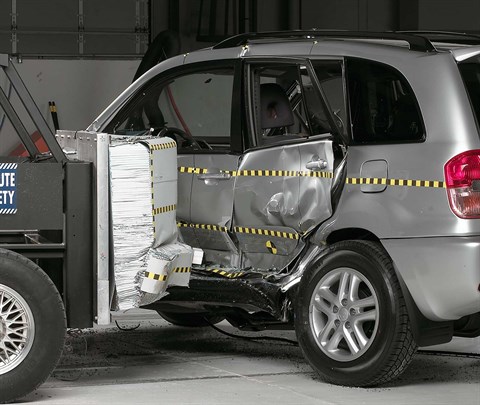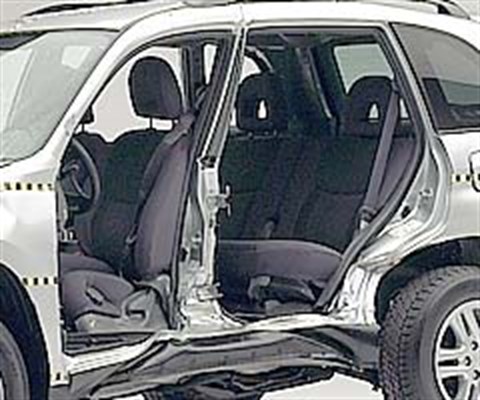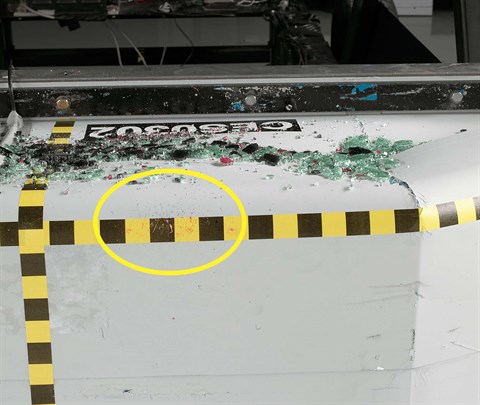Moderate overlap front: original test
Rating applies to 2004-05 models built after December 2003
Tested vehicle: 2004 Toyota RAV4 4-door 4wd
The Toyota RAV4 was redesigned for the 2001 model year, and advanced frontal airbags were added to 2004 models. All RAV4 models manufactured after December 2003 also include structural changes to improve occupant protection in frontal offset crashes (note: information about when a specific vehicle was manufactured is on the certification label typically affixed to the car on or near the driver door).
The Insurance Institute for Highway Safety has evaluated the crashworthiness of a 2004 RAV4 with the structural changes in a 40 mph frontal offset crash test into a deformable barrier.
| Evaluation criteria | Rating |
|---|---|
| Overall evaluation | |
| Structure and safety cage | |
| Driver injury measures | |
| Head/neck | |
| Chest | |
| Leg/foot, left | |
| Leg/foot, right | |
| Driver restraints and dummy kinematics | |

Action shot taken during the frontal offset crash test.

The dummy's position in relation to the steering wheel and instrument panel after the crash test indicates that the driver's survival space was maintained well.

Smeared greasepaint indicates where the dummy's head hit the B-pillar and roof rail during rebound. Head accelerations from these hits were low.

Forces on the lower right leg were high enough to indicate the possibility of injuries.
Side: original test
Rating applies to 2004-05 models
Tested vehicle: 2004 Toyota RAV4 L 4-door 4wd with optional front and rear head curtain airbags and optional front seat-mounted torso airbags
The Toyota RAV4 was redesigned for the 2001 model year. Beginning with 2004 models, side airbags were added as options and structural changes were made to improve occupant protection in side-impact crashes. (Toyota reported that the structural changes alone would not significantly affect side-impact performance; therefore, the overall side impact rating for 2004-05 models without side airbags is the same as for 2001-03 RAV4s.)
| Evaluation criteria | Rating |
|---|---|
| Overall evaluation | |
| Structure and safety cage | |
| Driver injury measures | |
| Head/neck | |
| Torso | |
| Pelvis/leg | |
| Driver head protection | |
| Rear passenger injury measures | |
| Head/neck | |
| Torso | |
| Pelvis/leg | |
| Rear passenger head protection | |

View of the vehicle and barrier just after the crash test.

View of the vehicle after the crash with doors removed, showing the side airbags and damage to the occupant compartment.

Action shot taken during the side impact crash test showing the driver dummy's head was protected from being hit by hard structures by the side curtain airbag.

Smeared greasepaint shows where the rear passenger dummy's head was protected by the side curtain airbag.
Rating applies to 2001-05 models
Tested vehicle: 2003 Toyota RAV4 L 4-door 4wd without optional side airbags
The Toyota RAV4 was redesigned for the 2001 model year. Beginning with 2004 models, side airbags were added as options and structural changes were made to improve occupant protection in side-impact crashes.
Note: Toyota reported that the structural changes alone would not significantly affect side-impact performance; therefore, the overall side impact rating for 2004-05 models without side airbags is the same (Poor) as for 2001-03 RAV4s. However, based on an Institute test of a 2004 RAV4 with side airbags, the structure rating improves to Acceptable for all 2004-05 models.
| Evaluation criteria | Rating |
|---|---|
| Overall evaluation | |
| Structure and safety cage | |
| Driver injury measures | |
| Head/neck | |
| Torso | |
| Pelvis/leg | |
| Driver head protection The dummy's head was hit by the intruding barrier. This impact did not produce high head injury measures, but head hits with intruding objects such as other vehicles, trees, and poles should be prevented. | |
| Rear passenger injury measures | |
| Head/neck | |
| Torso | |
| Pelvis/leg | |
| Rear passenger head protection The dummy's head was hit by the window sill and glass of the rear passenger door. These impacts did not produce high head injury measures, but the head protection is inadequate. | |

View of the vehicle and barrier just after the crash test.

View of the vehicle after the crash with doors removed, showing damage to the occupant compartment.

Action shot taken during the side impact crash test showing the driver dummy's head being hit by the intruding barrier.

Smeared greasepaint and glass marks show where the driver dummy's head hit the barrier.
Head restraints & seats
Seat type: All seats
| Overall evaluation | |
|---|---|
| Dynamic rating | |
| Seat/head restraint geometry |
About the head restraint & seat test
Currently, IIHS tests apply only to front seats.
